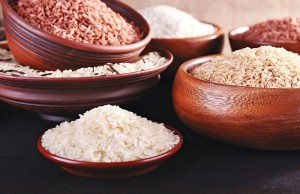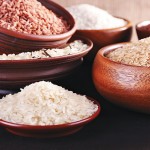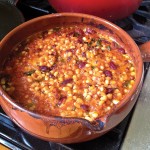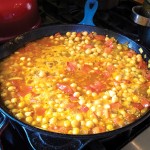The many lessons of the $2 a day food challenge
story by Emily Worts

Around this time last year my family and I embarked on a food challenge that turned out to challenge more than just what we put on our plates. The Live Below the Line initiative is a global anti-poverty campaign that invites families and individuals to take a hard look at how and what they eat by spending less than $2 a day on food, for five days, with the goal of spreading awareness of the hardships faced by those who live in extreme poverty.
After we announced our intentions on social media, our community quickly rallied around our Live Below the Line challenge. Several friends, family members and strangers joined us, some donated money and still others showed up on our doorstep in support, with muffins or other goodies. The camaraderie and money we gladly accepted – together with our friends we raised $4,000 for Tin Roof Global, a local water charity – but the muffins (and even asparagus from our neighbour’s garden) we had to refuse; the rules of the challenge said so. We also weren’t allowed to use rice and other staples from our pantry unless we priced out each serving. Foraging, however, was acceptable, so I gathered leeks, wild ginger and fiddleheads to supplement my lentils, beans and rice. I made bread daily from scratch (as did my 15-year-old nephew, who took on the challenge with us) and I picked spilled grains from the floor and plunked them in the Dutch oven instead of sweeping them up. My husband and I shared one tea bag each day, we traded in boxed cereal for oatmeal, and we said goodbye to fresh fruit, vegetables, dairy and meat.
It quickly became clear how unrealistic the challenge was, but at least the conversation was happening, in an honest, deep and meaningful way. The discussions we had around the dining room table and in the schoolyard made all of us, aged 6 to 76, question how and what we eat. To think our lives for that week were in any way comparable to those whom poverty forces to live on $2 a day is ludicrous (for starters we have access to clean water, fuel and food all day, every day), but it was a jumping off point.
Now, a year after my family and I took the Live Below the Line challenge, I look back on what we took from that experience. We’ve since bought a bread maker, we soak and cook our beans instead of buying canned, we forego boxed cereal, and we try not to throw anything out. Just the other day my six-year-old son Remy was lamenting the fact that all the remaining kiwis in the fruit bowl were too soft for his liking. Having adopted our ‘no food waste’ policy, he quickly came up with a solution. He had me on Google before I could come up with my own suggestions, searching for kiwi muffin recipes. Together we made two-dozen muffins, which provided our family of four with a sweet snack for each day of the following week.
Food waste in Canada is astounding. The Cut Waste, Grow Profit, 2014 report suggests that almost half (47 per cent) of the estimated $31 billion of food wasted in Canada every year ends up in household garbage cans and green bins as unwanted leftovers. That’s over $14 billion dollars of food waste annually from homes alone!
This waste doesn’t only end up at our curbside. As consumers we have very high expectations for the quality and quantity of our food. We want aesthetically pleasing apples, we want a lot of them and we want them cheap. The energy and resources we put into the production and delivery of that food blows my mind: infrastructure, labour, energy, disposal fees, packaging, repackaging and transportation are just a few examples of the supplementary costs associated with food waste. We are among the world’s most well-fed people, and it’s easy to take this for granted at every meal. T
aking a long look at how we eat, how much we eat and how much we waste is sobering.
The one aspect of this challenge that raised a red flag for me, as we tried to eat as ‘cheaply’ as possible, was this: as Canadians we have become accustomed to an abundance of cheap food, most of which is either heavily processed or travels thousands of miles to get here. But when you visit Creemore’s 100 Mile Store or Collingwood’s Currie’s Farm Market, you are seeing the real cost of real food. As most farmers and producers working their booths at weekly farmer’s markets will tell you, even though their prices may be slightly higher than those found at large supermarket chains, they are still not high enough to keep farmers out of the red. Our farmers are our best source for healthy, fresh, local food, but they are struggling.
Good food is expensive. And it should be. We spend a fortune taking care of our bodies in so many ways (a trip to the salon, a little R and R on the beach, supplements and teeth whitening … the list is endless), but when it comes to food we always look for the best deal and the cheapest price. I am as guilty of this as the next person. When my boys started drinking a litre and a half of milk a day, I stopped buying organic. Our own village has a dairy and yet that milk is considered a treat in our family. Yet, ironically, we don’t think twice about supporting our local brewery regardless of its premium prices.
For me and my family, there is a complete mind and lifestyle shift, still in the works, thanks to the lessons of the five-day food challenge. We learned – and are still learning – to slow down and prepare good, healthy meals using real food; to search out quality over quantity; to appreciate where we live and to support the growers who support us. Most of all, we are learning to prioritize our budget to sustain our own health and that of our community.
The old adage, “you are what you eat” really does apply. Eating for $2 a day taught my family that what we eat – as well as how we eat – can make a huge difference on so many levels. ❧
RECIPE
No-Knead Bread
I found this recipe online during our challenge and it quickly became a staple in our house. It beats the bread maker every time in flavour and texture (although it is not quite as convenient). It uses no special ingredients, equipment or techniques, and it requires very little effort — only time (it takes 24 hours to create the bread, but most of that is unattended waiting for the slow fermentation of the dough that results in a perfect loaf). The recipe is one of the most popular the New York Times has ever published, for good reason! I have adapted it slightly but not much.
Ingredients
• 3 cups all-purpose or bread flour, plus a little more for dusting
• ¼ teaspoon instant yeast
• 1 ¼ teaspoons salt
• 1 5/8 cups water
Preparation
- In a large bowl combine flour, yeast and salt. Add water and stir until blended; dough will be a bit tacky and sticky. Cover bowl with plastic wrap. Let dough rest at least 12 hours, at warm room temperature.
- Dough is ready when its surface is dotted with bubbles. Lightly flour a work surface and place dough on it; sprinkle it with a little more flour and fold it over on itself once or twice. Cover loosely with plastic wrap and let rest about 15 minutes.
- Using enough flour to keep dough from sticking to work surface or to your fingers, shape dough into a ball. Generously coat a cotton tea towel with flour (this is important or it sticks to the towel and creates quite a mess). Put dough seam-side down on towel and dust with more flour. Cover with another cotton towel and let rise for about 2 hours. When it is ready, dough will be double in size.
- At least a half-hour before dough is ready, heat oven to 450°F. Put a large heavy covered pot (cast iron, enamel, Pyrex or ceramic) in oven as it heats. When dough is ready, remove pot from oven and turn dough over into pot, seam side up; shake pan once or twice if dough is unevenly distributed.
- Cover with lid and bake 30 minutes, then remove lid and bake another 15 to 30 minutes until loaf is browned. Cool on a rack and enjoy!

















